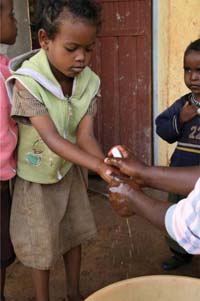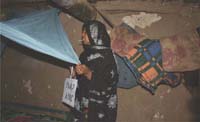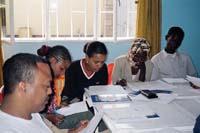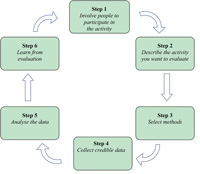16.5 Steps in the evaluation of health education activities
In this section, you will learn the steps that you can follow to evaluate your health education activities. Evaluation is not conducted in a haphazardly way, and there are six steps that are usually taken when conducting an evaluation of health education activities. In developing the evaluation steps, you will be able to put the methods we have discussed into the broader context of your local situation and the work you do. Look carefully at Figure 16.8. It shows the six steps usually involved in the evaluation of health education activities. You should note that evaluation, similar to planning health education activities, is a continuous process. Based on the feedback gained from evaluation, you will develop another plan, and so the process continues.
These six steps are interdependent, and the earlier steps provide the foundation for subsequent progress. Thus, you could not jump to Step 2 without having undergone Step 1, and so on. In the following section, you will be able to learn about each of these steps in more detail.
Step 1: Involve people to participate in the activities
You should begin the evaluation cycle by engaging people who have been taking part in your health education activities. For example, it will be useful to meet with community members, key informants, NGOs in the locality, and others who have participated in the activities. If you fail to involve them, your evaluation might not address certain important aspects. If you do the evaluation by yourself and later tell them the findings, they may not take any notice of the findings because the evaluation has not addressed their interests.
NGOs are non-governmental organisations.
Step 2: Describe the activities to be evaluated
In order to carry out an evaluation, you need to describe the activities being evaluated in detail. This enables you to determine the objectives, activities, methods and materials—as well as the content of the messages used in the activities being evaluated. In doing so, you will be able to focus on what you have planned and what you have achieved. For example, if you want to evaluate the family planning health education activities that you have undertaken through home visits, you need to describe in detail how you have been conducting those health education activities in people’s homes.
Step 3: Select methods
In this step, you will need to select appropriate evaluation methods to use. You could select observation (Figure 16.9), or interviews, or use other methods, depending on what you want to evaluate. Moreover, you need to decide who you want to interview, and when to interview them. Prepare all the necessary resources needed to conduct the evaluation.

Step 4: Collect credible data
The data that is collected in order to conduct an evaluation is the most important step. You can use multiple data collection methods, such as observation, interviewing and discussion, at the same time. For instance, you may go to a family and observe whether their health-related practices have changed in any way (Figure 16.9 above). At the same visit you can also interview the mother or head of the household to know more in detail about their health practices. The method you use should be appropriate and sufficient to give you the information you need to know. For example, if you want to know how well households are using mosquito nets, direct observation might be more reliable than asking someone else (Figure 16.10).

Step 5: Analyse the data
Once you have collected all the relevant data from various sources, the next step is to analyse and interpret the data (Figure 16.11). Analysis involves presenting the information you have collected in such a way that it gives meaning. For example, you can convert the raw data to percentages and numbers that will be relevant to people who need to know about the outcomes of the evaluation. For example, the number of pregnant women who attend antenatal care sessions, and the percentage of women who use family planning, are results of evaluation that might be of interest to the participants and other agencies.

Step 6: Learn from evaluation
The last step of evaluation deals with judging your achievements. In this step, you look at the extent to which you have achieved your objectives, particularly behavioural and learning objectives. If the achievement is encouraging and you appear to have done the right thing, then it demonstrates that the methods, materials and the messages you have used have probably worked. So you can learn from this evaluation, and should be able to replicate these approaches in your future health education activities.
On the other hand the evaluation findings may tell you that you have not done so well. This could mean that you have achieved only a portion of your behavioural and learning objectives. The evaluation findings should not only tell you the extent to which you have achieved your objectives, but also the possible reasons for your failure. These weaknesses should not be repeated. This is one of the basic purposes of conducting evaluation.
What is the difference between evaluation methods and evaluation steps?
Evaluation methods are the specific techniques that can be used to gather the data for evaluation. For instance, observation, interviews and focus group discussions are all evaluation techniques, whereas evaluation steps are the procedures that you follow when you evaluate your own health education activities. In other words, evaluation methods are Steps 3 and 4 of the entire evaluation activity. As Figure 16.8 shows, the steps are starting evaluation by involving local people, describing the activities being evaluated, selecting methods, collecting data, analysing the data, and learning from the evaluation findings. What we are emphasising here is that evaluation methods form part of evaluation steps.
16.4 Evaluation methods

